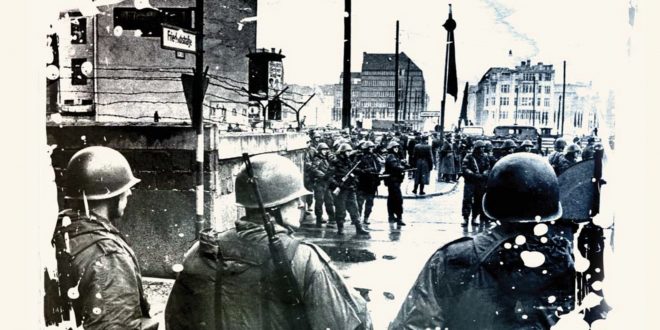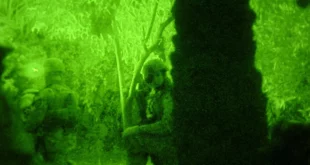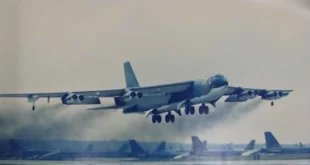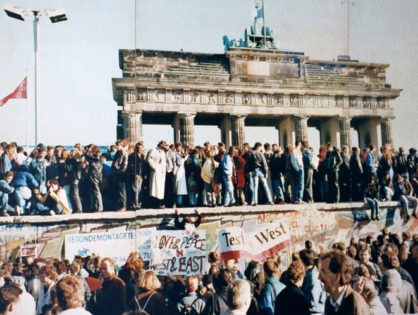
The Year Communism Ended In Europe: the Berlin Wall
On November 9, 1989, after serving as the symbol of the Cold War for decades, the Berlin Wall fell. Its demise signaled the dawn of change not only in Eastern Europe, but the world. From various CIA archives
THE STANDOFF AT CHECKPOINT CHARLIE, OCTOBER 27, 1961
During the end of summer and into the fall of 1961, the Soviets and East German governments continued
a general harassment of US forces traveling from Checkpoints Alpha and Bravo, which allowed access through East Germany, and a series of threats
were made by Soviet leaders concerning unfettered access to air corridors as well. Military and Allied diplomats were also harassed moving across the borders of the divided city. On 22 October 1961, just two months after the construction of the wall, the US Chief of Mission in West Berlin, E. Allan Lightner, Jr. was stopped in his car (which had occupation forces license plates) while crossing at Checkpoint Charlie to go to a theater in East Berlin. This violated agreements made at the 1945 Potsdam Conference. It was at that point that General Lucius Clay, Special Advisor in West Berlin, decided to demonstrate American resolve.
The next day, Clay sent an American diplomat
to test the East German border police. When the diplomat was stopped by East German transport police asking to see his passport, waiting US Military Police at the border recognized his diplomatic car, and rushed to escort him into
East Berlin. The shaken GDR police moved out
of the way. The car continued on and the soldiers returned to West Berlin. Over the next three days American and Soviet soldiers deployed at Checkpoint Charlie tested each country’s resolve on how far each would go during these standoffs over Berlin. On October 24, 26 vehicles were stopped by East German police, only to have US military personnel escort the vehicles across the border and return back to the West.
On October 27, 1961, the provocative games took
a serious turn as another probe prompted the Soviets to deploy 10 tanks on the Eastern side of Checkpoint Charlie. The US had been using tanks to support their escorts of vehicles into East Berlin, and now was met by equal force. The Soviet and American tanks stood a mere 100 yards apart from each other, and both sides readied for battle. The showdown of tanks at the wall became a visual emblem of the dangerous situation these world powers were locked into. The confrontation made headlines around the world, and it looked as if the Cold War was soon to become a hot, shooting war with grave consequences. It was only after more sanguine heads prevailed that Moscow and Washington mutually agreed to pull back from the standoff, and the confrontation eased.
The Berlin Wall started as a barbed wire fence built by the communist East German state (with approval from the Soviet Union) to stop the flow of refugees from East Berlin into West Berlin. For years, the CIA had predicted the East German government would take stern measures to stop border crossers but did not have tactical forewarning that a barrier would be put up starting on August 13, 1961. Stretching 96 miles long, the fence eventually evolved into the now familiar 12 foot high concrete wall, built in 45,000 separate sections, each four feet wide.
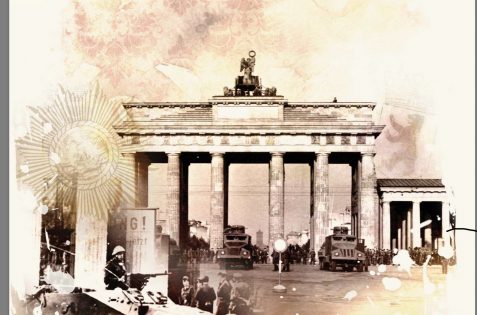
The Berlin Wall divided East Berlin and West Berlin for 28 years, from 1961 until November 1989. Typical for totalitarian states, the East German government declared the Wall to be a necessary defense against Western aggression. In reality, the Wall was intended to stop East Germans from seeking freedom in the West. In 1962, a second barrier was placed 100 yards back, creating a no-man’s land, widely known as the “death strip,” useless for defense against the West but clearly intended to prevent escape. It was booby-trapped with tripwires, offered no cover, and provided a clear field of fire to the watching guards. Even so, some 5,000 East Berliners escaped into the western half of the city. Tragically, an estimated 200 people died trying. Although the East German government always denied having a “shoot to kill” policy, the border guards were told to treat attempted defectors—even women and children—as criminals and stop them by whatever means necessary.
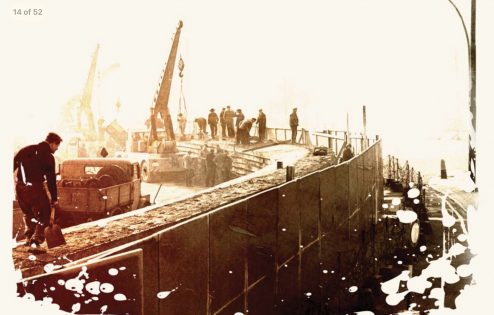
The Wall proved a propaganda disaster for the Soviet bloc as a whole. It became a powerful symbol of communist tyranny that Western leaders, starting with President John F. Kennedy, frequently denounced. In 1987, Ronald Reagan gave his famous speech at the Brandenburg Gate, at which he challenged Soviet leader Mikhail Gorbachev to “tear down this wall.”
Two years later, during the summer of 1989, communist Hungary removed its border restrictions with Austria, and in September, more than 13,000 East German tourists in Hungary escaped to Austria. Demonstrations broke out all over East Germany. The long-time leader of East Germany, Erich Honecker, who in January had predicted that the Berlin Wall would stand for “a hundred more years,” resigned on October 18, replaced by Egon Krenz. By November 4, 1989, the protests had increased significantly, with a million people gathered that day in Alexanderplatz in East Berlin. Meanwhile, the wave of refugees leaving East Germany for the West had increased through Czechoslovakia, tolerated by the new Krenz government and the communist regime in Prague.
To ease the complications, the Krenz government decided on November 9, 1989, to allow refugees and even private travelers to exit directly through crossing points between East Germany and West Germany, including West Berlin. The new regulations were to take effect the next day, on November 10, to allow time to inform the border guards. However, no one told the East German government spokesman, who had not been briefed on the situation but simply had been handed a note to announce that East Berliners would be allowed to cross the border with proper permission. He read the note aloud at the end of the conference and, when asked when the regulations would come into effect, he replied, “As far as I know, effective immediately, without delay.” Nobody, including the East German government, knew that on November 9, 1989, the Wall would start coming down.
Tens of thousands of East Berliners heard the spokesman’s statement live on East German television and soon flooded the checkpoints in the Wall, demanding entry into West Berlin. The surprised and overwhelmed border guards tried to call their superiors, but no East German official was willing to take personal responsibility for issuing orders to use lethal force. Faced with the swelling crowd, the guards finally yielded, opening the checkpoints and allowing people through with little or no identity checking. Ecstatic East Berliners were soon greeted by West Berliners on the other side in a celebration of freedom and reunion. As a result, November 9 is considered the date the Wall fell.
In the days and weeks that followed, people came to the Wall with sledgehammers to chip off souvenir pieces. The first concrete section of the Wall was removed on the 12th. By June 13, 1990 the wall was officially dismantled, and on October 3, 1990 East and West Germany were reunified. The collapse of the Soviet Union would soon follow.
While it is often repeated by some that the CIA and the US Intelligence Community (IC) missed the fall of the Soviet Union, assessments from the time tell a different story. With the demise of the Berlin Wall and the Soviet system in crisis, the CIA in 1989 assessed the Soviet Union under Gorbachev would not survive. In 1990, the IC released a National Intelligence Estimate(NIE), in which it stated, “the Soviet Union as we have known it is finished.(PDF)” (The NIE is an assessment by as many as 17 government agencies and departments regarding a national, regional or transnational issue of high importance, such as the Soviet Union, and is normally briefed to the President and other very senior officials). By the spring of 1991, the CIA warned of a future coup against Gorbachev, how it would take place, and the likelihood of the Soviet Union’s collapse—all accurate predictions of what happened soon after. On December 25, 1991, Gorbachev resigned and the Soviet Union ceased to exist; Its fifteen constituent Soviet republics became fifteen independent countries.
The fall of the Berlin Wall foreshadowed the demise of the communist governments of Eastern Europe and the formal dissolution of the Soviet Union, thus serving as the symbolic end of the Cold War.
by Kristyna Foltynova RfE
 Soldier of Fortune Magazine The Journal of Professional Adventurers
Soldier of Fortune Magazine The Journal of Professional Adventurers


